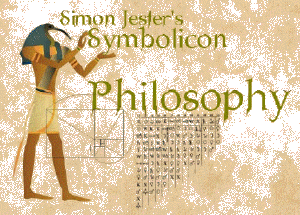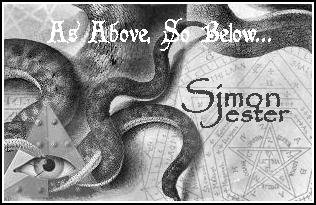
Magical Correspondences & Their
Conceptual Foundations
by Simon Jester (copyright 2007)
Almost every book on magic contains tables of correspondences. Such tables are as omnipresent in magical literature as the Periodic Table of the Elements is in chemistry texts, and we soon learn that the correspondences listed are just as important to magicians as the Periodic Table is to chemists. The correspondence tables themselves provide lists that bring together apparently diverse phenomena under distinct categories, and, typically, few of the combinations provided seem to make much sense at first. Sephiroth, strange names, Tarot cards, planets & zodiac signs, mythological deities, Biblical personages, animals, plants, perfumes and incenses, colors, minerals and metallic elements are all depicted as interconnected in some mysterious fashion, and the initial impact of such large, exotic groupings on someone unfamiliar with esoteric philosophy is usually one of utter bewilderment!
Learning to understand what these long, eccentric, and often inconsistent lists of things are all about requires a basic familiarity with a very old and highly respectable magical theory called the theory of correspondences. It also necessitates a brief examination of some fundamental philosophical systems that continue to influence the ways we think about things today. This effort is justified by the fact that the success of any magical operation depends directly upon a sound understanding and skillful employment of correspondences.
To begin, then, we ask the following questions: "What are correspondences, anyway? How do we determine that one thing corresponds to another? And why is the use of correspondences important in magic? "
By definition, a correspondence is a kind of connection that exists between things. In a manner of speaking, smoke may be said to be a correspondence of fire and the occurrence of one of these phenomena usually indicates the presence of the other. The nature of the correspondence between fire and smoke is obviously causal, but the kinds of relationships posited between something and its magical correspondences are often not this obvious and require a little research and meditation in order to appreciate. Why, for example, should the chemical element iron be a correspondence of the planet Mars? Surely there is no causal connection between the two, and the correspondence makes little sense until one learns, through a study of mythology, that Mars was a god of war and that the correspondence itself probably dates from the time when iron weapons were the most effective form of arms in use on the battlefield. The association of the planet Mars with various war gods is probably much older and based on the reddish color of the planet. Red is the color of blood and blood is spilled in battle and in other acts of aggression, so the connection with war and deities of battle makes sense.
Many of the hidden connections behind other magical correspondences are even more obscure, but the major premise on which the correspondence theory itself rests is actually quite comprehensible. The assumption that supports this theory is that the universe (on both the macrocosmic and microcosmic levels) has been created by and consists of a number of combined divine forces. Consequently, the phenomena we encounter in our experience are amalgamations of different forces in varying proportions. Each individually existing thing "embodies" and is thus "influenced by" the supernatural forces that brought it into being and is characterized most essentially by whichever force predominates in its nature. Thus we can say that an herb like cyan pepper corresponds with the element fire because of the immediately noticeable burning sensation it produces on the tongue, or that the metal silver is lunar because it embodies the metallic sheen of the moon.
As noted above, the manner in which things correspond to each other is not always causally explainable. Sometimes, of course, a causal relationship can be determined. The moon, for example, exerts an observable influence on the tides and so water is frequently listed as a correspondence of the moon. But most correspondences are based on the principles of similarity and frequent association. The ancient Greeks observed that the Egyptian deity Thoth was said to act in ways quite similar to their own Hermes, and so a correspondence between these two gods was formed. People so often observe Yew trees in graveyards that this frequent association forms a correspondence between Yews and many other ideas about death.
In the history of magic, the belief arose that the earthly correspondences of a given divine force bestow the ability to tap into or magically control the force itself. To use the example given above, a practitioner of black magic might try to kill an enemy by burying a Yew tree branch near the enemy's home, believing that the Yew's correspondence with death would magically exert a toxic effect. One way to explain how this works employs a physical model in which spiritual phenomena are interpreted as the activities of highly rarefied substances. Just as radium emits x-rays, all things are believed by some thinkers to emit a kind of astral "radioactivity" peculiar to the divine force which most essentially influences them & which they most essentially embody.
This particular explanation of correspondences immediately opened the arena of practical magic in a very simplistic manner. All one needed to do was ascertain the hidden correspondences between divine forces and their manifestations in the material world and then learn the method of manipulating these manifestations in order to take advantage of the powers which they embodied. Such a view, which may be called magical materialism, sounds naïve when stated so plainly. It all too easily lends itself to the notion that magic was a crude forerunner of science, eventually abandoned by rational people after years of empirical experimentation revealed the actual material properties and practical potentials of things. It also leads to merely superstitious practices in which magic is seen as just a matter of external formalism, a type of ritualistic performance in which one "goes through the motions" without understanding their meaning or experiencing any of the inner transformations sought for by true initiates of the Mysteries.
In spite of its materialistic assumptions, this view still exerts a powerful hold on occultists. Frequently found in works on magic which date from the 19'th and early 20'th centuries (and which are still avidly read today), this idea clearly influences explanations of so-called "ectoplasmic" manifestations and can also be seen in the many theories which define the Astral Light as a kind of "etheric fluid" similar to that hypothesized by scientists during the pre-Quantum Physics era. In fairness to certain occult theorists, it must be pointed out that many of them did not accept this materialistic model as anything more than a clumsy analogy to which they resorted for reasons of simple pragmatism. Dion Fortune, who resorted to an etheric concept of the Astral Light in many of her major works, openly acknowledged the shortcomings of such a view and defended her use of this notion on the pragmatic grounds that phenomena behave "as if" such a theory were factual. Aleister Crowley, who used the somewhat materialistic-sounding phrase "The Method of Science" as part of the motto for his famous Equinox publications, was even more blatant in his assertions that the various explanatory entities postulated by magicians possessed no literal reality. Crowley, ever the pragmatist, judged this as being of little consequence when compared to the practical results obtained by magical operations.
Another interpretation of magical correspondences, one that avoids the crudities of magical materialism, evolved at the opposite end of the dialectical spectrum. This approach adopts a kind of magical idealism that arose when Jewish mystics assimilated Platonic & Neo-Platonic theories, along with various Gnostic & Hermetic elements, into the Merkhaba tradition and formulated the linguistic mysticism familiar to students of the Qabalah--gematria being one of the more prominent offshoots of this multifaceted metaphysics. This complex and sophisticated Qabalistic philosophy ultimately views reality as a system of interconnected ideas emanated by the Mind of a Divine Thinker rather than as a conglomerate of different kinds of substances.
In this system, correspondences are defined in terms of a mysterious "participation" that can be described non-physically. The connection between items in a list of magical correspondences is similar to the relationship that obtains between words and the things to which they refer, or between symbols and the things symbolized. Existing things in the material universe are looked at as expressions of divine ideas that can be comprehended by an intellectual process of understanding, just as books can be read in order to gain knowledge of the ideas of their authors. This idealistic theory motivates the Paracelsian admonition to "read from the Book of Nature" and underlies Jacob Boehme's doctrine of the signatura rerum—the secret names of things, written by God on all of His creations, which can be discerned by the enlightened mind. It also provides the rationale behind the many methods of linguistic permutation, such as gematria, notariqon, and temurah, practiced by Jewish mystics like Abraham Abulafia and his followers.
Magical materialism aims at practical results, but the major goal of magical idealism is enlightenment. It places the focus of magical practice on inner transformation and, through meditation on correspondences and the hidden meaning of letters, numbers, words, and Divine Names, the mystically minded magician can experience revelations of occult significance and elevate his mind to the point where he attains gnosis: a direct insight into the Mind of God. Consequentially—as one can well imagine—all the magician's social interactions and motives are dramatically metamorphosed by the attainment of this enlightening gnosis, and so practical results do actually follow upon the successful culmination of magical work. But these practical results are often deemed as being of secondary importance by proponents of magical idealism, and one of the dangers of this view is that it tends to turn magic into a very isolating kind of head-trip unless one takes the precaution of remaining grounded in practical reality.
Observant readers of contemporary magical literature will notice that the materialistic and idealistic premises discussed above often blend together in the works of various writers to form exotic conceptual hybrids which, when subjected to strict rational analysis, appear lacking in logical consistency. This fact does not discourage magicians because they are very much aware of the fact that reality can be described by a multiplicity of different conceptual systems, each one of which imposes its own peculiar limitations. When trying to describe and explain phenomena, we use the linguistic tools that are currently available to us. In the case of magical phenomena like the various correspondences and their observed power to enhance magical operations, the material object language and the subjective idea language generate explanations that are ultimately of only limited usefulness. Every system casts its shadow, and throws in darkness something that another system illuminates. And, since magic is a practice that aims at the transcendent, it necessarily involves a kind of stretching of thought and language beyond the "comfort zone" established by logical reasoning in its attempt to reach outward and upward into higher territory.
